Safeguarding the lives of pedestrians and drivers stands at the core of automotive innovation. Most car systems rely on Advanced Driver Assistance Systems (ADAS) to achieve this goal, which leverages multiple sensors (radars, lidars and cameras) integrated with processing units installed inside the cars to provide perception, and allow it to react to external factors.
However, their effectiveness is confined within the car's perception field, limited by sensor range and obstacles like blocking objects and weather conditions.
This is what Vehicle to Everything (V2X) comes to change. V2X encompasses the communications between cars, pedestrians and the road infrastructure enabling new ways to both enhance safety as well as facilitate driving. V2X has the potential to reshape how transportation currently works, making cities and roads safer and better for everyone.
In this article, we will delve into V2X, explaining the concepts behind it and exploring related technologies, benefits, challenges and use cases.
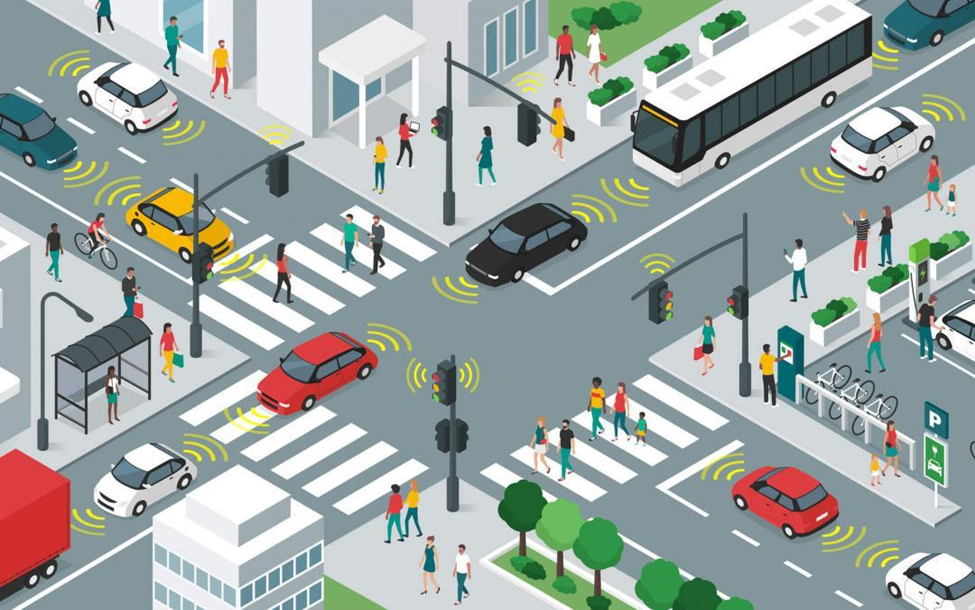
What is V2X and how this technology can reshape transportation and make cities and roads better and safer for everyone? Source: What is Required for an Vehicle-to-Everything (V2X) Deployment? (frost.com)
V2X communications
As mentioned before V2X stands for Vehicle 2 Everything communication, is the idea to connect and exchange information between multiple devices involved in transportation with the goal to improve safety and enhance traffic flow.
V2X encompasses multiple communication technologies:
- Vehicle to Vehicle (V2V): Refers to the direct communication between vehicles allowing them to share relevant information such as position and speed as well as possible dangers detected by the vehicle’s sensors. This can be used to prevent accidents and to improve traffic flow. V2V provides greater value in situations where the line of sight is limited, such as at intersections or blind spots.
- Vehicle to Infrastructure (V2I): Refers to the communication between vehicles and roadside infrastructure, such as traffic lights, road signs, weather sensors and other edge elements of the transportation infrastructure. Using V2I, vehicles can be notified of a potential hazard on the road as well as additional information such as how long it will take for a traffic light to open.
- Vehicle to Pedestrian (V2P): V2P allows vehicles to communicate with pedestrians’ personal devices, such as a cellphone, and alert them. For example, pedestrians can receive warnings from nearby vehicles if they are about to enter a crosswalk when it's unsafe.
- Vehicle to Network (V2N): V2N allows vehicles to communicate with external networks such as the internet or central clouds. This can be used to access real-time data such as traffic analysis, weather updates, parking locations, etc. This also allows the vehicle to share information, and receive updates, enabling advanced services such as predictive maintenance, remote diagnostics, real-time route planning,
etc.
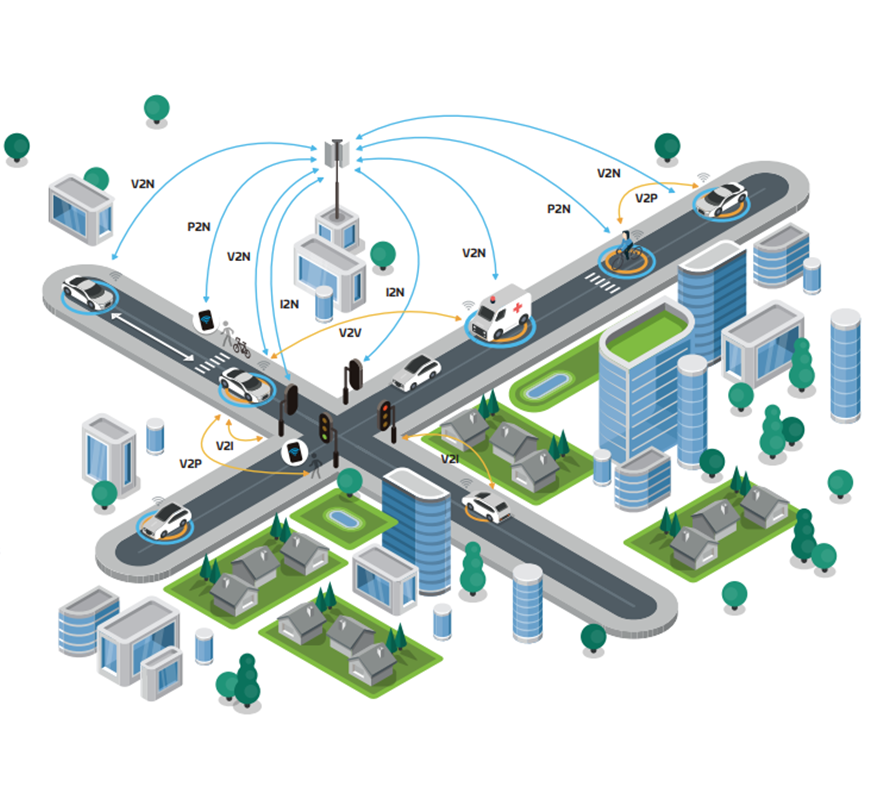
Types of V2X communication (Source: C-V2X explained - 5GAA)
Technologies
There are 2 technologies driving V2X communications: Cellular Vehicle-to-Everything (C-V2X) and Direct Short-Range Communications (DSRC).
DSRC was introduced in the Institute of Electrical and Electronics Engineers (IEEE)’s 802.11p standard, a vehicular communication protocol intended for adding wireless access in vehicular environments (WAVE). WAVE uses WLAN technology to establish dedicated short-range communication (DSRC) channels that the vehicles can use to send and receive messages within short to medium ranges. The independence of intermediaries represented a big advancement as enabled communication in rural and remote areas that lack telecommunications infrastructure for example. Also, direct connections can provide lower latencies which is important in critical situations.
Approved in 2010 DSRC has undergone extensive testing conducted by both government bodies and private companies, involving numerous field trials. Toyota introduced this capability on selected Japanese market models in 2015 and Cadillac added it to the CTS in 2017 for the US market. More recently, in 2019 in Europe, the eighth-generation Golf was released by VW with DSRC V2X capability. In Europe the technology is also referred to as the ETSI ITS-G5 standard.
In 2017, C-V2X was standardized, defined by 3GPP standards (LTE-V2X: Release 14 ,15; 5G-V2X: Release 16, 17). Unlike DSRC, C-V2X leverages the existing cellphone network to provide both direct and indirect communication. Direct communication on C-V2X works similarly DSPRC, providing direct communication between vehicles and devices. For indirect connections C-V2X leverages existing mobile network and technologies to provide communication between vehicles and other entities through the network (V2N). For direct connections C-V2X relies on the PC5 interface specified by 3GPP. Indirect connections uses the existing Uu interface.
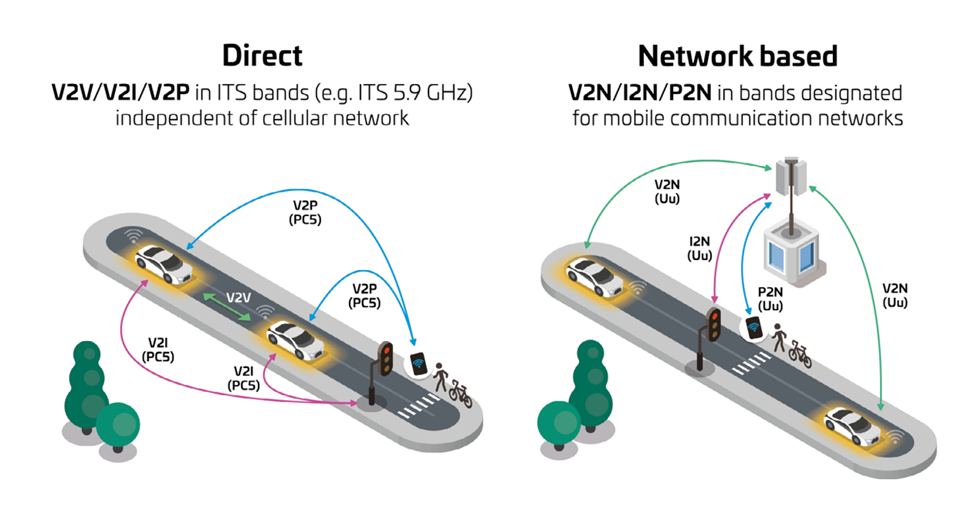
Direct and indirect V2X communications (Source: 5GAA Roadmap for advanced driving | Setember 2020)
This approach allows for tailored communication based on the scenario at hand. For example, urgent and latency critical messages could be sent via direct connection while less urgent messages can utilize indirect communication. C-V2X can also benefit from new technologies such as 5G and Edge Processing to handle a higher volume of data and connections, providing supplementary assistance for safety-related features, as well as other commercial services from third parties.
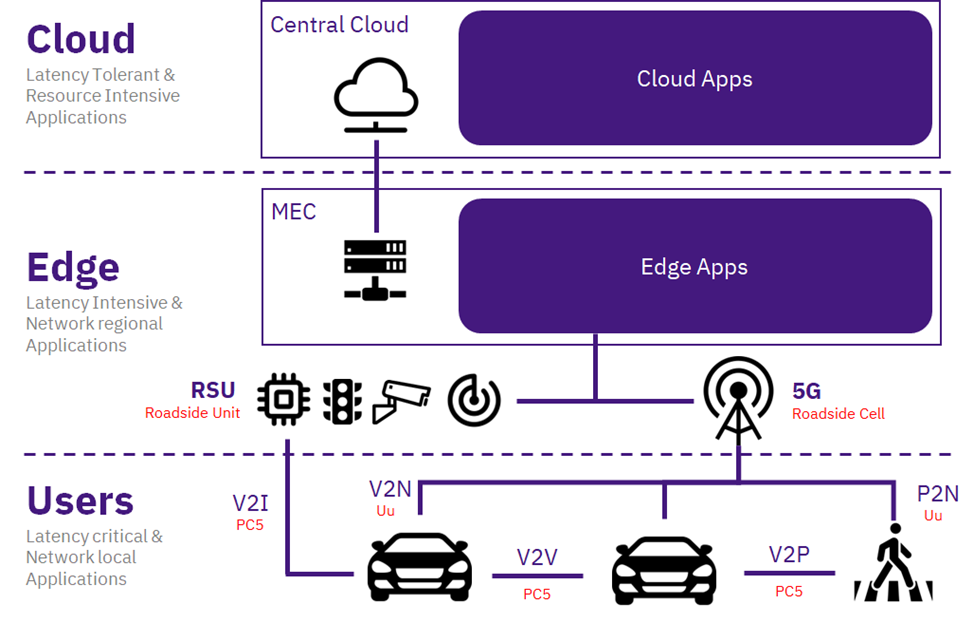
Hierarchical architecture of MEC for C-V2X service (source: 5G Americas white paper – Vehicle connectivity: C-V2X & 5G)
Even though DSRC initially gained ground in Japan and Europe, C-V2X is also gaining significant popularity specially in the United States and China.
In the United States recently the Federal Communications Commission (FCC) granted a joint waiver for Audi, Ford and Jaguar Land Rover to deploy C-V2X technology in the specified states alongside 9 equipment manufacturers.
In China, Ford announced this year (2023) the launch of C-V2X services in Changchun, the capital city of Jilin Province. Ford's C-V2X services have been effectively integrated into six cities across China, namely Wuxi, Changsha, Guangzhou, Xi'an, Wuhan, and Nanjing. Presently, Ford's C-V2X technology has been installed in more than 330,000 vehicles in production. Additionally, the total number of users utilizing Ford's C-V2X system in China has surpassed 36,000, with over 12,000 active service users.
Industry Initiatives and Use Cases
CAR 2 CAR Communication Consortium (C2C-CC)
C2C-CC is a nonprofit, industry-driven organization initiated by European vehicle manufacturers and supported by equipment suppliers, research organizations and other partners.
C2C-CC primarily concentrates on the development and promotion of Cooperative Intelligent Transport Systems (C-ITS), which is enabled by V2X communication. Cooperative Intelligent Transport Systems (C-ITS) encompass transportation systems where collaboration between multiple Intelligent Transport System (ITS) sub-systems, including personal devices, vehicles, roadside infrastructure, and central systems, enables the delivery of enhanced ITS services.
C2C-CC provides a good summary of some of the V2X enabled use cases, including Day 1 use cases that are already being deployed to more advanced Day 2 and Day 3+ use cases. They grouped the use cases in an evolutionary way, ranging from awareness driving to cooperative driving. The level of automation and safety provided increase from one level to the other.
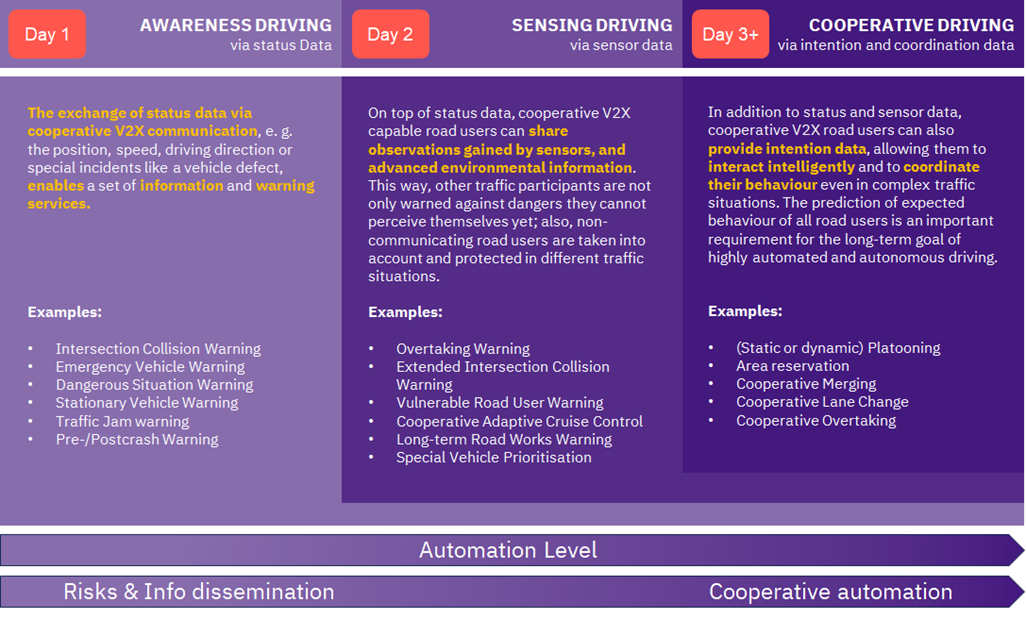
Levels of Automation and Safety (source: CAR 2 CAR Journal – Issue 22 | March 2019)
5GAA
5GAA is a global, cross-industry organization of companies from the automotive, technology, and telecommunications industries (ICT), working together to develop end-to-end solutions for future mobility and transportation services. Created in September 2016, 5GAA has rapidly expanded to include key players with a global footprint in the automotive, technology and telecommunications industries. Some examples from the automotive industry are Continental, Hyundai, BMW, Denso, Honda, Pirelli and many others. 5GAA is one of the entities supporting the C-V2X technology mentioned before.
5GAA aims to bridge the automotive and telecommunication industries to address connected mobility needs bringing inclusive access to smarter, safer and environmentally sustainable services and solutions, integrated into intelligent road transportation and traffic management.
Similarly to C2C-CCC, 5GAA also shares a list of interesting use cases, in an evolutionary approach, ranging from connected driver warning to connected cooperative driving.
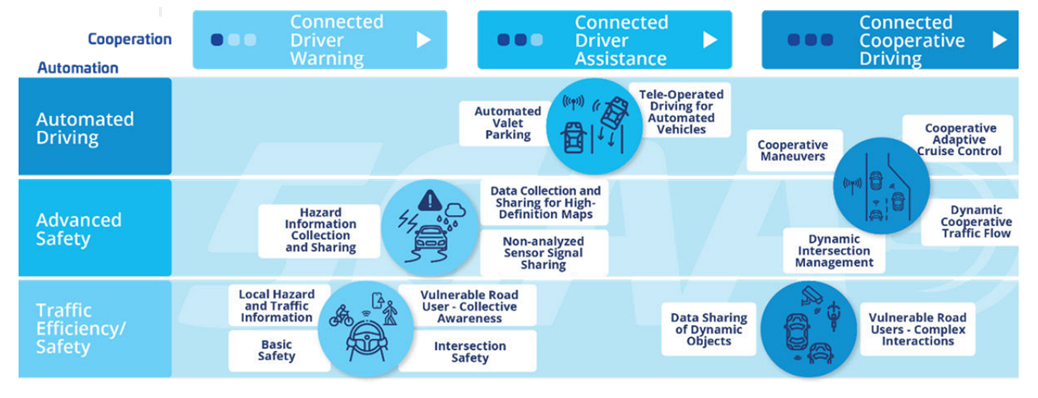
Evolution of C-V2X use cases towards connected cooperative driving (Source: 5GAA Roadmap for Advanced Driving | January 2023)
Demonstrations
In this section we will share some industry demonstrations of V2X technology:
- Qualcomm CES 2019 Live C-V2X interoperability demonstration showcasing 3 use cases: Maneuver negotiation, Pedestrian crossing warning and Intersection movement assistance.
- Smart Work Zone System: Virginia Tech Transportation Institute (VTTI) researchers have partnered with the Virginia Department of Transportation (VDOT) and GeoStabilization International to deploy a smart work zone technology system in a work zone along U.S. Route 23 in Wise, Virginia. Designed to protect roadside workers and motorists, the works zone system creates a digital boundary and alerts workers when they approach its edge or when a danger is identified such as a vehicle that is speeding or out of control, keeping them safe from potential hazards.
- Cyclist Warning: Audi held demonstrations of Connected Vehicle to Everything (C-V2X) technology in Oceanside, California. The demonstrations showcased a variety of C-V2X use cases which offer the potential to reduce the likelihood of collisions between vehicles and cyclists.
Benefits
Wrapping it all up let’s summarize some of the V2X benefits discussed in the preceding sections:
- Enhance Safety: V2X allows vehicles, infrastructure and pedestrians to communicate with each other delivering real-time updates on location, speed, weather condition and potential dangers, increasing awareness and reducing accidents. An important example of that is the potential to improve Micro-Mobility and Pedestrian Safety. Two of the biggest causes for micro-Mobility (electrical scooters, bicycles, etc.) and pedestrians’ accidents are “failure to see” and “driver’s distraction” – V2X alerts drivers to the presence of vulnerable road users, even when obscured by other vehicles or infrastructure elements.
- Optimize Traffic and Efficiency: Smart traffic management solutions can be used to redirect traffic to less congested roads, reducing traffic congestion and fuel consumption, thus also reducing harmful emissions.
- Unlock Autonomous Driving: One of the challenges of autonomous driving is dealing with potential dangers that are beyond the perception field of the vehicle. V2X can specifically address this issue, by providing out-of-line-of-sight awareness.
- Better Transportation System Management: Through real-time data exchange between vehicles and infrastructure, V2X empowers transportation agencies to better supervise and manage road networks and transportation vehicles while also enabling quick responses to traffic incidents.
- Improve Driving Experience: By providing communication between the vehicles and external services, V2X also enables advanced services such as smart parking (helping drivers find available parking spaces), predictive maintenance, automatic roadside and emergency assistance and many others.
Challenges
V2X is a promising technology that can bring significant improvements in road safety and traffic control, however, as any emerging technology it faces challenges that needs to be addressed by collaborative work between companies, researchers and governments. Some of these challenges are:
- Investment: Significant investments are required to Implement V2X networks such as investments in roadside infrastructure, sensors and communication devices as well as investments on the car’s Onboard Unit (OBU).
- Regulatory Framework: The necessity for well-defined regulations and standards is crucial for the successful integration of V2X technology. Clear and consistent guidelines, both within individual regions and globally, are essential. They not only address cross-regional challenges but also provide a solid foundation for the seamless adoption of V2X, ensuring interoperability, safety, and efficient communication across diverse platforms and jurisdictions.
- Interoperability: For V2X to work, seamless communication between different vehicle brands and models, as well as various infrastructure components, is necessary. Standardizing protocols and initiatives to ensure compatibility is crucial.
- Security and Data Privacy: As any other network, V2X communication networks are vulnerable to cyber-attacks. Safeguarding these networks against hacking, data breaches, and malicious interference is paramount to maintaining the safety and privacy of users, especially as devices share sensitive information such as location inside V2X Networks. Regulations are also important to address data privacy concerns and build user trust.
- Reliability and latency requirements: Since V2X can play a critical role enhancing awareness as well as performing automatic actions to prevent accidents, these applications will demand low latency and high availability to be effective. Similarly, these applications must go through rigorous testing, validation, as well as safety certifications to ensure reliability and effectiveness under various conditions, including adverse weather, heavy traffic, and diverse geographical landscapes.
Expanding on the challenges previously mentioned, the central obstacle faced by V2X lies in ensuring widespread connectivity among cars, pedestrians, and city infrastructure through V2X-enabled devices within a unified V2X network. Achieving this is crucial for unlocking the full potential of the technology.
Nevertheless, even in its initial stages, V2X technology offers tangible advantages, particularly concerning safety in urban environments where existing roadside infrastructure already supports V2X. A notable illustration is the connected initiative in Las Vegas, developed by Commsignia in collaboration with Aptiv. This innovative approach involves integrating data from various sensors embedded in road infrastructure, including traffic cameras and radars. By doing so, it becomes possible to identify pedestrians and vehicles not yet connected to the V2X network, sharing this information to enhance V2X vehicles' perception and augment overall safety measures.
Additionally, noteworthy global initiatives such as 5GAA and C2C-CCC, mentioned earlier, are working to overcome these challenges. Their efforts are instrumental for the evolution and establishment of V2X technology.
Key Takeaways
- V2X technology has the potential to revolutionize transportation by enhancing vehicles' and pedestrians' perception and enabling seamless coordination and cooperation. These advancements lead to improved safety and optimized traffic flow, fundamentally changing how we approach mobility.
- V2X can be integrated with 5G and Edge technologies, allowing for the handling of larger volumes of data from connected devices. This integration expands vehicles' perception range and enables advanced services, enhancing overall transportation capabilities.
- While V2X technology shows great promise, its full potential is still evolving. Companies, researchers, and governments are actively engaged in developing, standardizing, and legalizing V2X deployments. Current use cases, while relevant, represent only a glimpse of the technology's full capabilities.
Acknowledgement
This piece was written by Guilherme Carrenho, Innovation Expert at Encora. Thanks to João Caleffi and Douglas Pereira for reviews and insights.